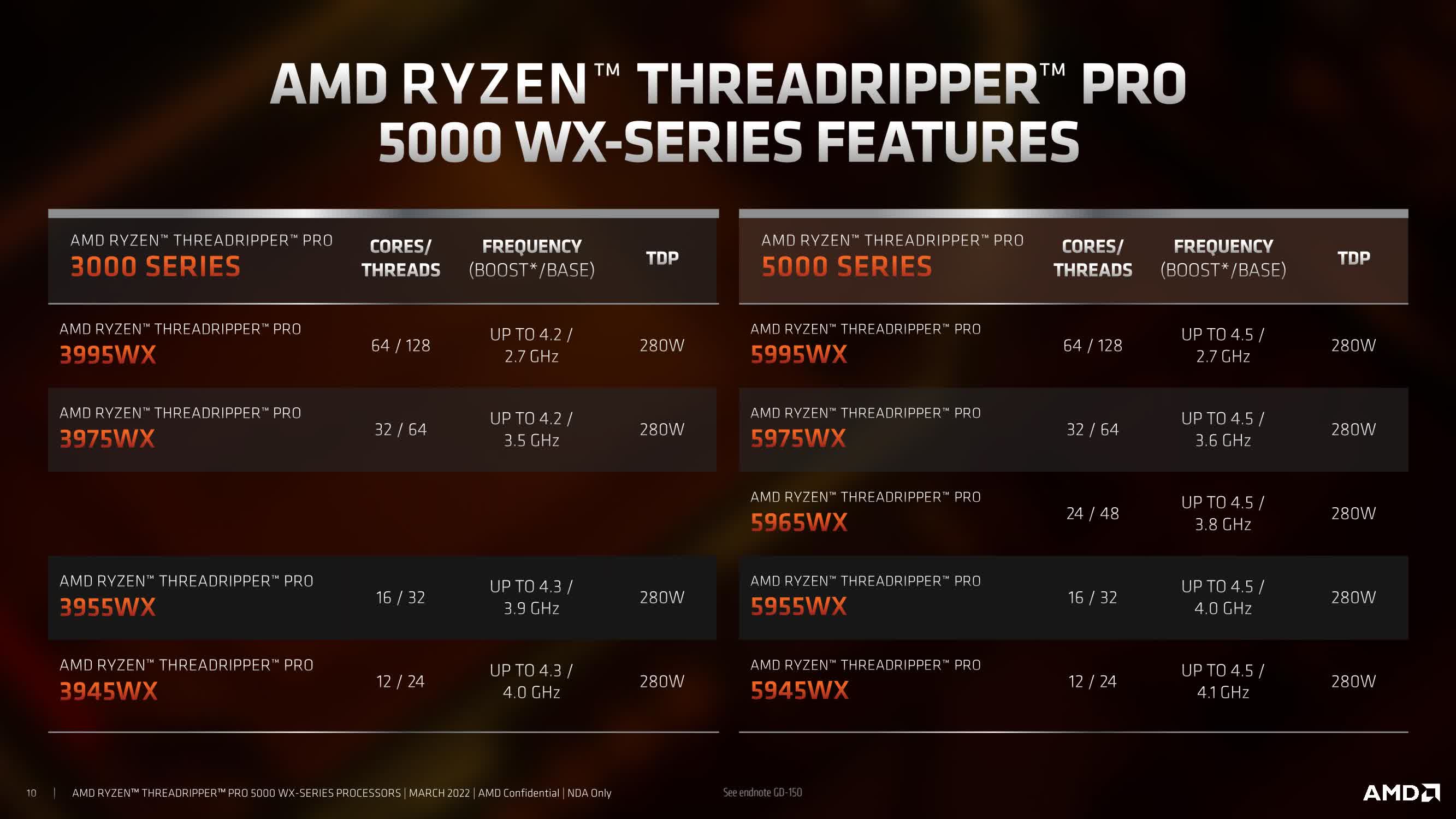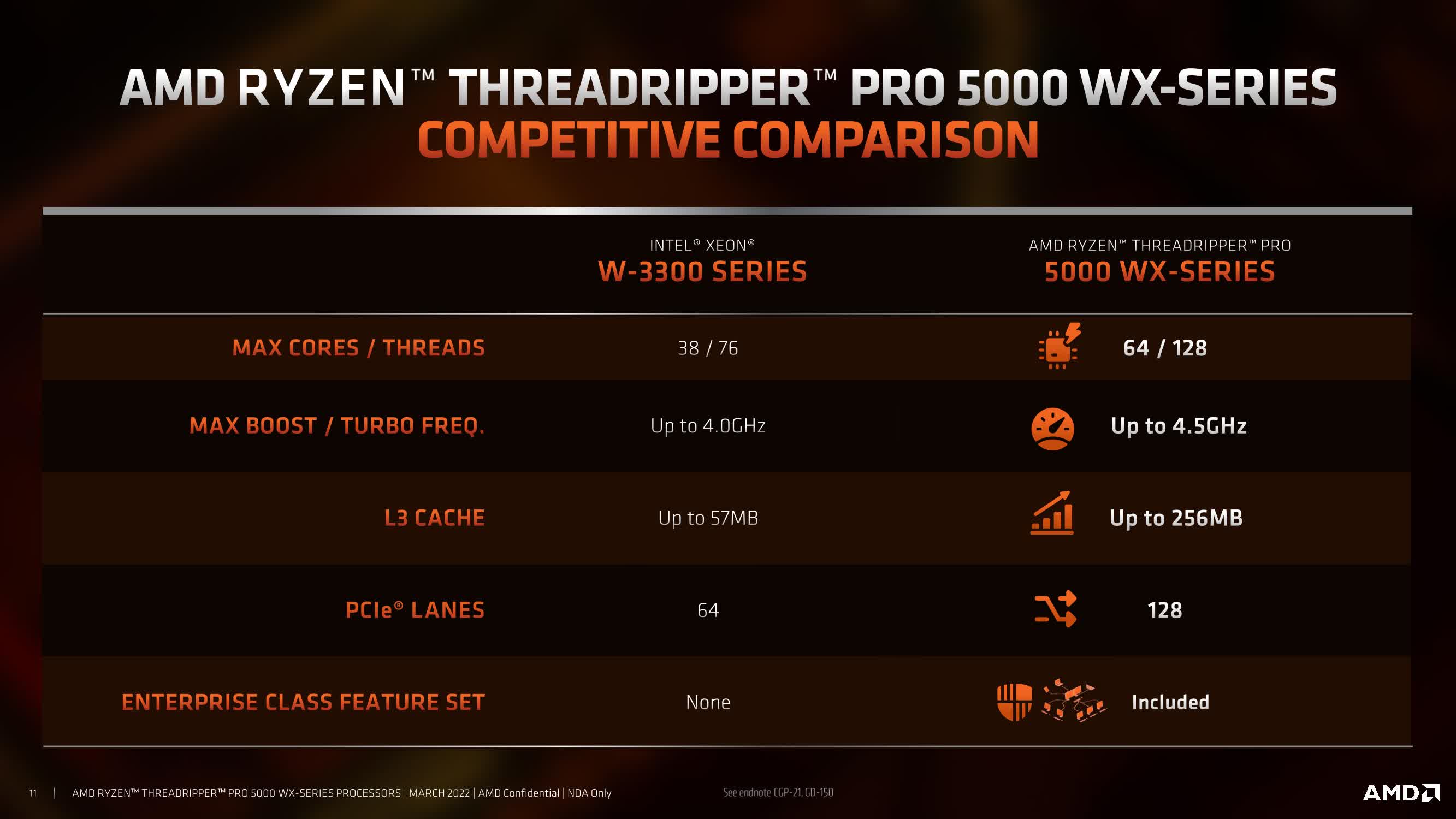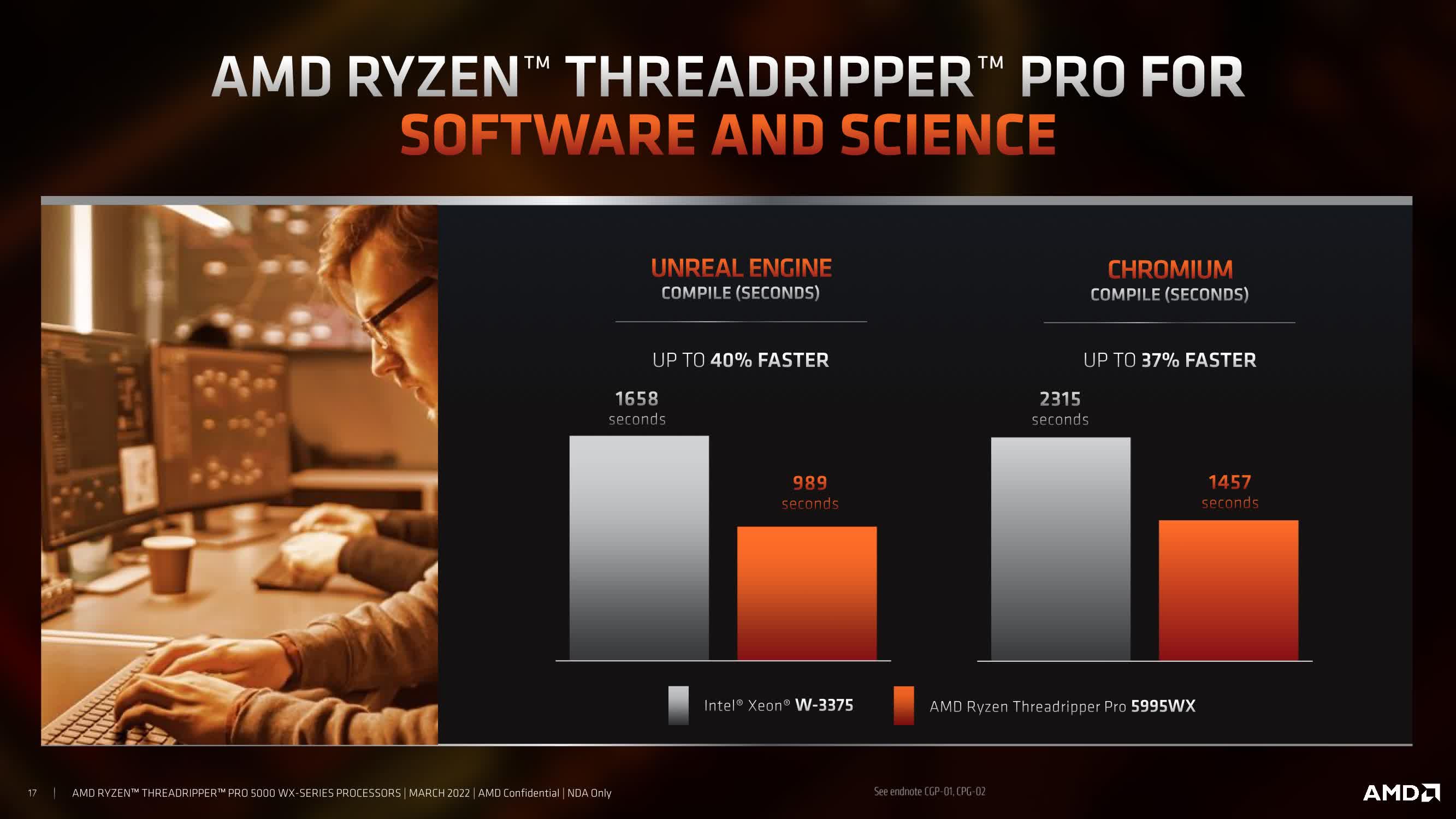The big picture: It's a really good time to buy a new CPU right now, and with this Threadripper update, we're finally getting a refresh of the current leader for high performance desktop workstations. There's been plenty of questions over where Zen 3-based Threadripper products have been hiding, especially given the first desktop CPUs using AMD's latest architecture were released well over a year ago. That's a long wait for a Threadripper update, but the simple reality comes down to two factors: supply constraints and competition.
AMD's main focus for their big multi-die chips has been the server market. The demand for Epyc Milan CPUs has been extraordinary and so the majority of CPUs that might become Threadripper parts have been going to servers since the launch of Milan almost exactly one year ago.
It's a conscious business decision, and how could you blame AMD for this? The company has always wanted to steal some of that lucrative server market share away from Intel, and they have finally managed to do it. A top-end 64-core Epyc chip sells for over $7,000 in the server market, compared to $4,000 for the last-gen Threadripper 3990X.
The other factor is competition: Intel simply doesn't have the parts to compete with the existing Zen 2-based Threadripper line, let alone a Zen 3 model. The X series of enthusiast HEDT parts got stuck in the 10th-gen with Cascade Lake since 2019, which itself wasn't competitive upon launch, and since then the only real alternatives in Intel's stack has been Ice Lake-W which launched to little fanfare in mid-2021. Basically, we're not expecting a proper refresh of Intel's high-end workstation line until Sapphire Rapids launches later this year.
This is Threadripper Pro 5000
With AMD pumping out Epyc chips and facing little competition, they've been able to sit on Threadripper 5000 for some time - but it's here now, with the launch of the Threadripper Pro 5000 series based on the Zen 3 architecture.
The new line of products is exactly as you'd expect. Threadripper 5000 uses the same chiplet and I/O die design, with a large 14nm I/O die in the center flanked by up to eight CPU chiplets built on 7nm. But instead of Zen 2 chiplets with two CCXes inside and a split L3 cache system, the shift up to Zen 3 gives us all the usual advantages like a unified single CCX with all eight cores able to access the 32MB of L3 with ease. We're still getting 128 lanes of PCIe 4.0 from the CPU, and given these are Threadripper Pro, all eight DDR4 channels are available for use.
While the primary upgrade here is the shift from Zen 2 to Zen 3 and all the associated IPC benefits, Threadripper Pro 5000 CPUs are also clocked slightly higher in terms of boost frequency: 4.5 GHz vs 4.3 GHz previously. This applies to every Threadripper 5000 chip, so we're getting either a 200 or 300 MHz clock increase over the previous-gen 3000 series part. The 280W TDP remains the same.
AMD is offering everything from a 12-core chip in the Threadripper Pro 5945WX, right up to a 64-core in the Threadripper Pro 5995WX - including a 24-core model which wasn't available in the previous generation. This gives buyers options at every budget level.
Threadripper Pro vs Ryzen high core count
Now you might be wondering, why would AMD offer a 12 and 16-core Threadripper CPU when those core counts are already covered by the regular desktop Ryzen line with the Ryzen 9 5900X and 5950X?
There are some benefits for going Threadripper, such as if you need significant amounts of memory bandwidth, but don't especially need high core counts. The 5945WX has eight-channel DDR4 instead of two-channel like you'd get with the 5900X. The same applies to PCIe connectivity and any of the advanced pro-level features that Threadripper offers.
Then there's also the upgrade angle, getting a system with the 5945WX allows you to upgrade to a higher-end Threadripper part in the future on the same motherboard if your business and budget continues to grow.
With all of that said, it's the 64 and 32-core models that will gather the most sales and interest, which was the case with prior generations. It never hurts to have options though, and the inclusion of a 24 core part does balance out the line-up nicely.
Threadripper gen-on-gen improvements? OEM only.
Unfortunately, AMD did not provide any direct comparisons between the Threadripper Pro 5000 series and the previous 3000 series, so we don't know how much of an upgrade we're getting gen-on-gen. With that said, reviews for Epyc Milan server chips have shown impressive performance gains thanks to Zen 3's IPC advantage.
Instead AMD's performance data focuses exclusively on comparing Threadripper Pro 5000 to Intel's Xeon W-3300 series, which are Ice Lake workstation CPUs. According to AMD, their new parts are faster than Intel's parts in many key workstation and productivity applications, whether we're looking at best vs best, or products in a similar market segment.
The disappointing aspect to the Threadripper Pro 5000 launch is that these CPUs are not available for DIY system builders just yet. At this stage, they will be exclusive to OEM systems, in particular the Lenovo ThinkStation P620, which is the first system announced to use the 5000 series. There will be more OEM configurations coming soon, but this ThinkStation will launch in the coming month packed with Threadripper Pro 5000 chips.
The Threadripper Pro 3000 series was also OEM only, if you wanted to build a Threadripper system you had to get the non-Pro models which cut the number of PCIe lanes and memory channels in half. However it's been possible to buy the Pro variants if you really want to, but you'll usually need to opt for a "third party" seller at places like Newegg and then source an sWRX8 motherboard which were also OEM only.
AMD hasn't ruled out launching a Zen 3 Threadripper for the DIY market, but when we asked them about this they said this launch was specifically for OEM systems. So we might see Threadripper 5000 later on, especially if Intel releases a new HEDT series based on Sapphire Rapids. At least for now, we know these Threadripper chips exist and we're not in a perpetual state of rumors and leaks anymore.
Ryzen 5000 CPU price cuts, not official
Also worth discussing are the price cuts that have started appearing across major retailers for Ryzen 5000 parts. We spoke to AMD about this today, and we confirmed there's been no change to what AMD calls the "SEP" or suggested etailer price - in other words, the MSRP for AM4 processors has not been reduced... officially.
However that hasn't stopped retailers from adjusting AMD CPU prices to more closely align with current market conditions, where Intel CPUs are typically better value, especially in the mid and lower price tiers. These price drops could be part of "unofficial" price adjustments from AMD, it's not uncommon for discounts or sales to be accompanied by various agreements between retailers and manufacturers. But typically these deals aren't made "official" so they can be adjusted or ended at any time; doing this gives a bit more flexibility compared to a permanent price reduction.
The current state of these price reductions are roughly as follows...
The Ryzen 5 5600X has been dropped to $230 from $300, which puts it in a much better position to compete against the excellent Core i5-12400. In our testing, the 12400 was just 6% slower when gaming compared to the 5600X, while it trades blows with AMD's six-core part in productivity workloads. The 12400F's current asking price is $200.
The Ryzen 7 5800X has come down from $450 to just $350 which is a sizable price correction, but this makes sense given the 5800X was one of the least well priced parts in AMD's line-up. This is probably to make room for the upcoming Ryzen 7 5800X3D using AMD's 3D V-Cache technology, which should be coming to market soon. We don't have any pricing info yet, but if we had to guess, it'll probably launch around the original price of the 5800X.
This price adjustment was necessary when the 5800X is going up against Intel's Core i7-12700 parts, including the 12700F and 12700KF, which can often be found for $350 or less. Even at $350 the 5800X isn't a hugely competitive part, given the 12700 was typically faster in our testing, let alone the 12700KF (especially for productivity workloads) - but it's certainly a lot more competitive now.
Then we get the Ryzen 9 5900X which is currently sitting at $449, down from its $550 launch MSRP. This makes it about $100 more expensive than Intel's Core i7-12700K, but $100 cheaper than the Core i9-12900K. For gaming, it still makes the most sense to go with the 12700K, given it performs very similarly but is cheaper (or ideally go all the way down to the 12700F). But for productivity workloads, depending on the application, the 5900X can sit between Intel's unlocked Core i7 and Core i9 parts, so it's hard to go wrong with the Ryzen or the Intel CPUs.
The 16-core, 32-thread Ryzen 9 5950X has fallen from $800 to $599 today, which is a huge saving and clearly has been in response to the Core i9-12900K, which is selling for about the same price. But again, the 12900K is typically a little bit faster, depending on what you're testing, of course. Not a bad price by any means, but also not the clear leader.
When discussing these price points, the main focus is usually on the CPUs, but there are other factors to consider including motherboards and upgrade pathways. These price cuts are great news for existing AM4 owners that might be considering an upgrade to a Zen 3 CPU now or in the future. If you are already in that ecosystem, you probably won't consider switching everything over to Intel 12th-gen, which is why these price cuts aren't always putting AMD into the leading position - they do capitalize on buyers who will only consider an AMD upgrade though.
But for new system builders, there could be even bigger price cuts. AMD does have a small cost advantage when it comes to motherboards, X570 and B550 boards are usually cheaper than Z690 and B660 boards, respectively, but this doesn't always give AMD the platform cost advantage.
Other rumors floating around say that AMD might consider releasing new CPUs: names include the likes of a Ryzen 5 5500 and Ryzen 5 5600. These are unconfirmed reports though, and honestly parts like the 5600 aren't strictly necessary. AMD could just drop the 5600X's price to $200. So we'll have to wait and see what happens there.









